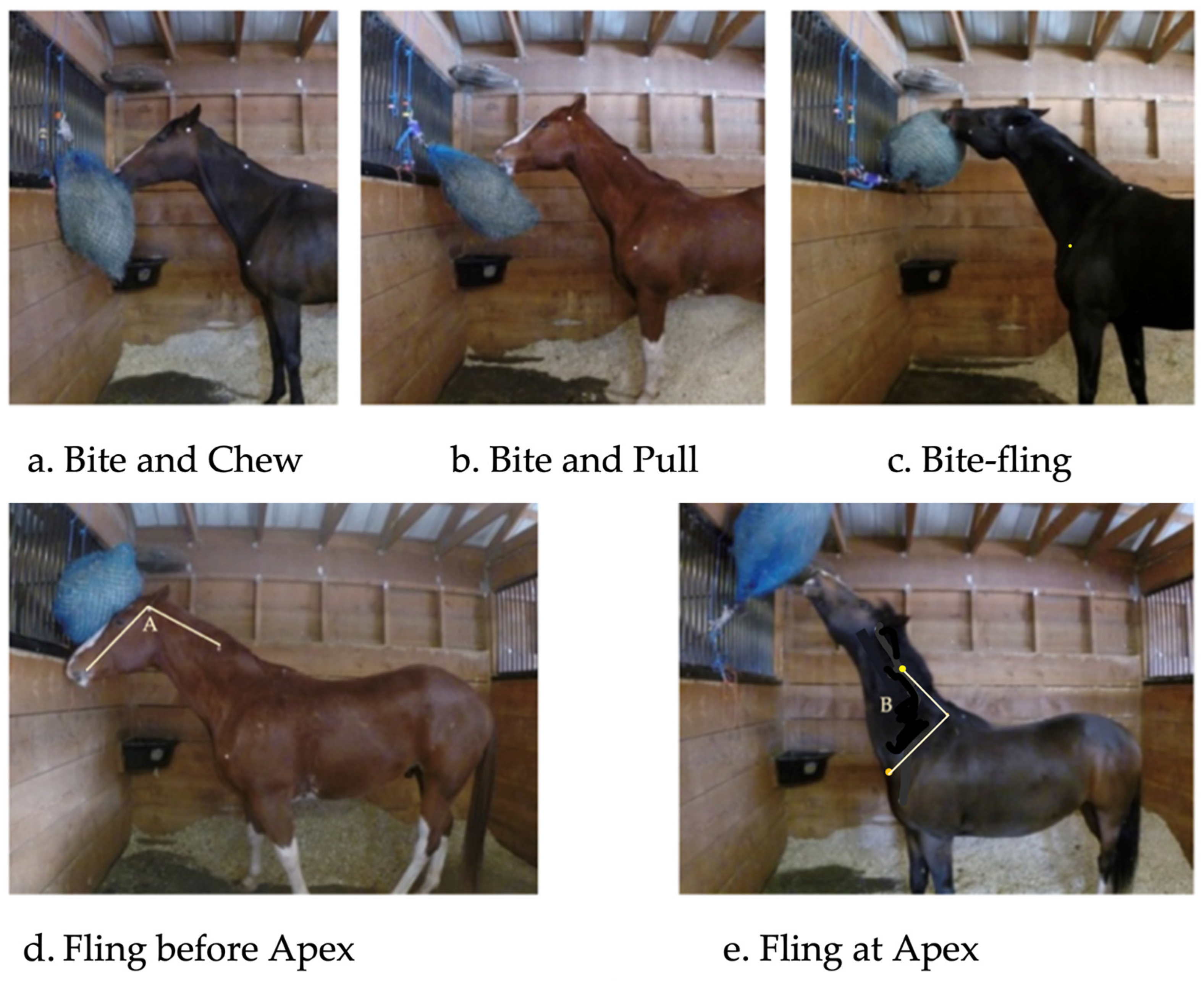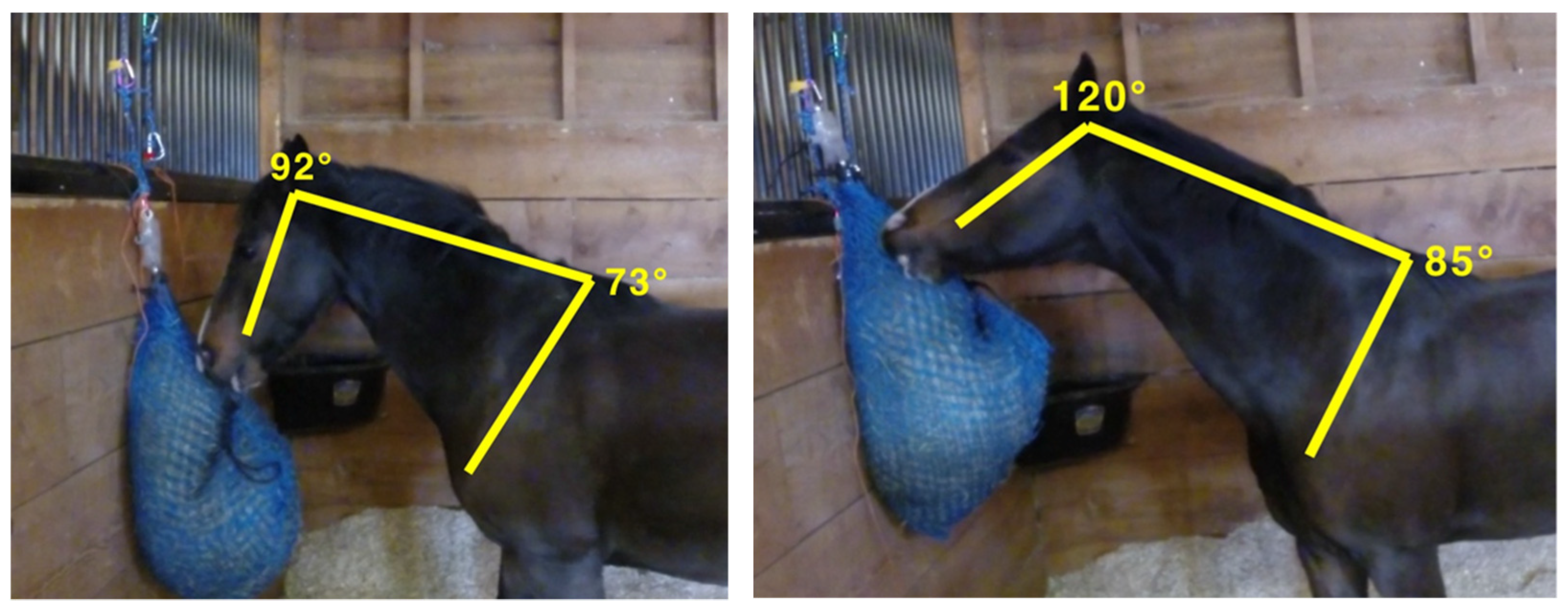Posture and Pull Pressure by Horses When Eating Hay or Haylage from a Hay Net Hung at Various Positions
Abstract
:Simple Summary
Abstract
1. Introduction
2. Materials and Methods
2.1. Study 1—Haynet Type
2.1.1. Study Design and Horses
2.1.2. Feeding Management and Hay Treatment
2.1.3. Measurements
2.1.4. Data Analysis
2.2. Study 2
2.2.1. Study Design and Horses
2.2.2. Measurements
2.2.3. Data Analysis
3. Results
3.1. Study 1
3.2. Study 2
3.2.1. Intake Behaviour
3.2.2. Other Variables
4. Discussion
4.1. Effect of Hanging Height on Posture and Bite Force (Study 1 in Context of Study 2 Results)
4.2. Limitations (Study 2)
4.3. Effect of Type of Forage and Attachment (Study 2)
5. Conclusions
Author Contributions
Funding
Institutional Review Board Statement
Informed Consent Statement
Data Availability Statement
Conflicts of Interest
References
- Ellis, A.D. Biological basis of behaviour and feed intake in horses. In The Impact of Nutrition on the Health and Welfare of Horses; EAAP Publication No. 128; Ellis, A.D., Longland, A., Coenen, M., Miraglia, N., Eds.; Wageningen Academic Publishers: Wageningen, The Netherlands, 2010; pp. 53–74. [Google Scholar]
- Harris, P.A.; Ellis, A.D.; Fradinho, M.J.; Jansson, A.; Julliand, V.; Luthersson, N.; Vervuert, I. Feeding conserved forage to horses: Recent advances and recommendations. Animal 2017, 11, 958–967. [Google Scholar] [CrossRef] [PubMed] [Green Version]
- Ellis, A.; Fell, M.; Luck, K.; Gill, L.; Owen, H.; Briars, H.; Barfoot, C.; Harris, P. Effect of forage presentation on feed intake behaviour in stabled horses. Appl. Anim. Behav. Sci. 2015, 165, 88–94. [Google Scholar] [CrossRef]
- Glunk, E.; Hathaway, M.; Weber, W.; Sheaffer, C.; Martinson, K. Original Research: The Effect of Hay Net Design on Rate of Forage Consumption When Feeding Adult Horses. J. Equine Vet. Sci. 2014, 34, 986–991. [Google Scholar] [CrossRef]
- Elia, J.B.; Erb, H.N.; Houpt, K.A. Motivation for hay: Effects of a pelleted diet on behavior and physiology of horses. Physiol. Behav. 2010, 101, 623–627. [Google Scholar] [CrossRef] [PubMed]
- Ellis, A.; Redgate, S.; Zinchenko, S.; Owen, H.; Barfoot, C.; Harris, P. The effect of presenting forage in multi-layered haynets and at multiple sites on night time budgets of stabled horses. Appl. Anim. Behav. Sci. 2015, 171, 108. [Google Scholar] [CrossRef] [Green Version]
- Harris, P.A. Review of equine feeding and stable management practices in the UK concentrating on the last decade of the 20th century. Equine Vet. J. 1999, 31, 46–54. [Google Scholar] [CrossRef] [PubMed]
- Benz, B.; Münzing, C.; Krüger, K.; Winter, D. Ethological investigation of hayracks in equine husbandry. Landtechnik 2014, 69, 5. [Google Scholar]
- Hongo, A.; Akimoto, M. The role of incisors in selective grazing by cattle and horses. J. Agric. Sci. 2003, 140, 469–477. [Google Scholar] [CrossRef]
- Lesimple, C.; Fureix, C.; Aubé, L.; Hausberger, M. Detecting and measuring back disorders in nonverbal individuals: The example of domestic horses. Anim. Behav. Cogn. 2016, 3, 159–179. [Google Scholar] [CrossRef]
- Alvarez, C.G.; Rhodin, M.; Bobbert, M.F.; Meyer, H.; Weishaupt, M.A.; Johnston, C.; Van Weeren, P.R. The effect of head and neck position on the thoracolumbar kinematics in the unridden horse. Equine Vet. J. 2006, 38, 445–451. [Google Scholar] [CrossRef] [PubMed]
- Clayton, H.M.; Singleton, W.H.; Lanovaz, J.L.; Cloud, G.L. Measurement of rein tension during horseback riding using strain gage transducers. Exp. Tech. 2003, 27, 34–36. [Google Scholar] [CrossRef]
- Clayton, H.M.; Larson, B.; Kaiser, L.J.; Lavagnino, M. Length and elasticity of side reins affect rein tension at trot. Vet. J. 2011, 188, 291–294. [Google Scholar] [CrossRef] [PubMed]
- Callaghan, J.P.; McGill, S.M. Intervertebral disc herniation: Studies on a porcine model exposed to highly repetitive flexion/extension motion with compressive force. Clin. Biomech. 2001, 16, 28–37. [Google Scholar] [CrossRef]
- Balsamo, R.A.; Vander Willigen, C.; Boyko, W.; Farrant, J. Retention of mobile water during dehydration in the desiccation-tolerant grass Eragrostis nindensis. Physiol. Plant. 2005, 124, 336–342. [Google Scholar] [CrossRef]
- Vincent, J.F. The influence of water content on the stiffness and fracture properties of grass leaves. Grass Forage Sci. 1983, 38, 107–114. [Google Scholar] [CrossRef]
- Geor, R.J. Metabolic predispositions to laminitis in horses and ponies: Obesity, insulin resistance and metabolic syndromes. J. Equine Vet. Sci. 2008, 28, 753–759. [Google Scholar] [CrossRef]
- Goodwin, D.; Davidson, H.P.B.; Harris, P. Foraging enrichment for stabled horses: Effects on behaviour and selection. Equine Vet. J. 2002, 34, 686–691. [Google Scholar] [CrossRef] [PubMed]
- Müller, C.E.; Udén, P. Preference of horses for grass conserved as hay, haylage or silage. Anim. Feed. Sci. Technol. 2007, 132, 66–78. [Google Scholar] [CrossRef]
- Thorne, J.B.; Goodwin, D.; Kennedy, M.J.; Davidson, H.P.B.; Harris, P. Foraging enrichment for individually housed horses: Practicality and effects on behaviour. Appl. Anim. Behav. Sci. 2005, 94, 149–164. [Google Scholar] [CrossRef]
- LaCasha, P.A.; Brady, H.A.; Allen, V.G.; Richardson, C.R.; Pond, K.R. Voluntary intake, digestibility, and subsequent selection of Matua bromegrass, coastal bermudagrass, and alfalfa hays by yearling horses. J. Anim. Sci. 1999, 77, 2766–2773. [Google Scholar] [CrossRef] [PubMed]













| Test Days | 1 | 2 | 3 | 4 |
|---|---|---|---|---|
| Phase 1 | ||||
| Group A—SH | SHhigh | SHlow | SHhigh | SHlow |
| SHlow | SHhigh | SHlow | SHhigh | |
| Group B—DH | DHhigh | DHlow | DHhigh | DHlow |
| DHlow | DHhigh | DHlow | DHhigh | |
| Phase 2 | ||||
| Group A—DH | DHhigh | DHlow | DHhigh | DHlow |
| DHlow | DHhigh | DHlow | DHhigh | |
| Group B—SH | SHhigh | SHlow | SHhigh | SHlow |
| SHlow | SHhigh | SHlow | SHhigh | |
| Day | 1 | 2 | 3 | 4 | 5 | 6 | 7 | 8 |
|---|---|---|---|---|---|---|---|---|
| Block 1 | HYs | HGs | HYd | HGd | HYs | HYd | HGs | HGd |
| Group | A | A | B | B | A | A | B | B |
| Block 2 | HYs | HGs | HYd | HGd | HYs | HYd | HGs | HGd |
| Group | B | B | A | A | B | B | A | A |
| Block 3 | HYd | HGd | HYs | HGs | HGs | HGd | HYs | HYd |
| Group | A | A | B | B | A | A | B | B |
| Block 4 | HYd | HGd | HYs | HGs | HGs | HGd | HYs | HYd |
| Group | B | B | A | A | B | B | A | A |
| Mean Pull Pressure (N) | Mean Max Pull Pressure (N) | Intake Time (minutes/kg WM) | |
|---|---|---|---|
| Study 1: Hay; 50–5000 N | SH: 74 ± 2.9 | SH: 122 ± 6.6 | Single: 78 ± 9 |
| DH: 81 ± 2 | DH: 156 ± 9.4 | Double: 154 ± 12 | |
| Study 2a: 50–2500 N | Hay: 77 ± 2.6 | Hay: 123 ± 11.1 | Hay: 44 ± 1.8 |
| Haylage: 135 ± 4 | Haylage: 307 ± 18.2 | Haylage: 27 ± 1.1 | |
| Study 2b; 0–2500 N | Hay: 20 ± 1.8 | Hay: 120 ± 13.6 | |
| Haylage: 74 ± 5.2 | Haylage: 307 ± 18.2 | ||
| Hongo & Akimoto (2003) Artificial swards | Perennial Rye Grass: 141 ± 11 * |
Publisher’s Note: MDPI stays neutral with regard to jurisdictional claims in published maps and institutional affiliations. |
© 2022 by the authors. Licensee MDPI, Basel, Switzerland. This article is an open access article distributed under the terms and conditions of the Creative Commons Attribution (CC BY) license (https://creativecommons.org/licenses/by/4.0/).
Share and Cite
Hodgson, S.; Bennett-Skinner, P.; Lancaster, B.; Upton, S.; Harris, P.; Ellis, A.D. Posture and Pull Pressure by Horses When Eating Hay or Haylage from a Hay Net Hung at Various Positions. Animals 2022, 12, 2999. https://doi.org/10.3390/ani12212999
Hodgson S, Bennett-Skinner P, Lancaster B, Upton S, Harris P, Ellis AD. Posture and Pull Pressure by Horses When Eating Hay or Haylage from a Hay Net Hung at Various Positions. Animals. 2022; 12(21):2999. https://doi.org/10.3390/ani12212999
Chicago/Turabian StyleHodgson, Samantha, Pam Bennett-Skinner, Bryony Lancaster, Sarah Upton, Patricia Harris, and Andrea D. Ellis. 2022. "Posture and Pull Pressure by Horses When Eating Hay or Haylage from a Hay Net Hung at Various Positions" Animals 12, no. 21: 2999. https://doi.org/10.3390/ani12212999
APA StyleHodgson, S., Bennett-Skinner, P., Lancaster, B., Upton, S., Harris, P., & Ellis, A. D. (2022). Posture and Pull Pressure by Horses When Eating Hay or Haylage from a Hay Net Hung at Various Positions. Animals, 12(21), 2999. https://doi.org/10.3390/ani12212999





